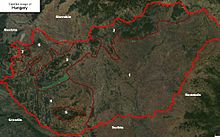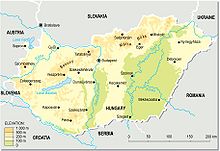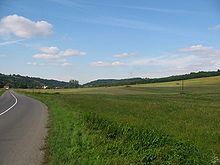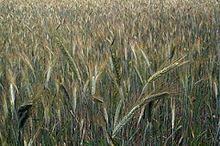- Geography of Hungary
-
 Satellite image showing the seven main geographical regions of Hungary (in parenthesis: major region):
Satellite image showing the seven main geographical regions of Hungary (in parenthesis: major region):
1., Great Alföld (Great Alföld)
2., North Hungarian Mountains (North Hungarian Mountains)
3., Transdanubian Mountains (Transdanubia)
4., Transdanubian Hills (Transdanubia)
5., Mecsek Mountains (Transdanubia)
6., Little Alföld (Transdanubia)
7., Alpokalja (Transdanubia)With a land area of 93,030 square kilometers, Hungary is a country in Central Europe. It measures about 250 kilometers from north to south and 524 kilometers from east to west. It has 2,258 kilometers of boundaries, shared with Austria to the west, Serbia, Croatia and Slovenia to the south and southwest, Romania to the southeast, Ukraine to the northeast, and Slovakia to the north.
Hungary's modern borders were first established after World War I when, by the terms of the Treaty of Trianon in 1920, it lost more than 71% of what had formerly been the Kingdom of Hungary, 58.5% of its population, and 32% of the Hungarians. The country secured some boundary revisions from 1938 to 1941: In 1938 the First Vienna Award gave back territory from Czechoslovakia, in 1939 Hungary occupied Carpatho-Ukraine. In 1940 the Second Vienna Award gave back Northern Transylvania and finally Hungary occupied the Bácska and Muraköz regions during the Invasion of Yugoslavia. However, Hungary lost these territories again with its defeat in World War II. After World War II, the Trianon boundaries were restored with a small revision that benefited Czechoslovakia.
Contents
Topography
Most of the country has an elevation of fewer than 200 meters. Although Hungary has several moderately high ranges of mountains, those reaching heights of 300 meters or more cover less than 2% of the country. The highest point in the country is Kékes (1,014 m) in the Mátra Mountains northeast of Budapest. The lowest spot is 77.6 meters above sea level, located in the south of Hungary, near Szeged.
The major rivers in the country are the Danube and Tisza. The Danube also flows through parts of Germany, Austria, Croatia, Slovakia, Serbia, and Romania.It is navigable within Hungary for 418 kilometers. The Tisza River is navigable for 444 kilometers in the country. Less important rivers include the Drava along the Croatian border, the Rába, the Szamos, the Sió, and the Ipoly along the Slovakian border. Hungary has three major lakes. Lake Balaton, the largest, is 78 kilometers long and from 3 to 14 kilometers wide, with an area of 592 square kilometers. Hungarians often refer to it as the Hungarian Sea. It is Central Europe's largest freshwater lake and an important recreation area. Its shallow waters offer good summer swimming, and in winter its frozen surface provides excellent opportunities for winter sports. Smaller bodies of water are Lake Velence (26 square kilometers) in Fejér County and Lake Fertő (Neusiedler See--about 82 square kilometers within Hungary).
Hungary has three major geographic regions (which are subdivided to seven smaller ones): the Great Alföld, lying east of the Danube River; the Transdanubia, a hilly region lying west of the Danube and extending to the Austrian foothills of the Alps; and the North Hungarian Mountains, which is a mountainous and hilly country beyond the northern boundary of the Great Hungarian Plain.
The country's best natural resource is fertile land, although soil quality varies greatly. About 70% of the country's total territory is suitable for agriculture; of this portion, 72% is arable land. Hungary lacks extensive domestic sources of energy and raw materials needed for industrial development.
Rivers and lakes
Rivers The springs of the major Hungarian rivers are outside the country. The two most important rivers, the Danube and the Tisza are navigable on their whole Hungarian length. They have several tributaries.
The country is rich in brooks and hot springs.
Name Length in Hungary Danube 417 km Tisza 596 km Lajta 180 km Rábca Rába 211 km Zala 139 km Dráva 725 km Ipoly 143 km Zagyva 160 km Sajó 125 km Hernád 118 km Bodrog 52 km Szamos Körös River Maros 48 km Lakes Hungary has several bodies of water, including the greatest lake of Central Europe, Lake Balaton, which is a famous tourist destination. Lake Hévíz, the largest thermal lake in the world (47,500 square metres in area) is located in Hungary as well. The Lake Cave (Hungarian: Barlangtó) of Tapolca is also notable as being a sub-surface lake. Major lakes include:
Name Surface in Hungary Balaton 596 km2 Tisza (artificial) 127 km2 Fertő 75 km2 Velence 26 km2 Plains and hills
-
- Main articles: Little Hungarian Plain, Transdanubia, Great Alföld.
The Little Alföld or Little Hungarian Plain is a plain (tectonic basin) of approximately 8,000 km2 in northwestern Hungary, southwestern Slovakia and eastern Austria, along the lower course of the Rába River, with high quality fertile soils.
The Transdanubia region lies in the western part of the country, bounded by the Danube River, the Drava River, and the remainder of the country's border with Slovenia and Croatia. It lies south and west of the course of the Danube. It contains Lake Fertő and Lake Balaton. The region consists mostly of rolling hills. Transdanubia is primarily an agricultural area, with flourishing crops, livestock, and viticulture. Mineral deposits and oil are found in Zala county close to the border of Croatia.
The Great Alföld contains the basin of the Tisza River and its branches. It encompasses more than half of the country's territory. Bordered by mountains on all sides, it has a variety of terrains, including regions of fertile soil, sandy areas, wastelands, and swampy areas. Hungarians have inhabited the Great Plain for at least a millennium. Here is found the puszta, a long, and uncultivated expanse (the most famous such area still in existence is the Hortobágy), with which much Hungarian folklore is associated. In earlier centuries, the Great Plain was unsuitable for farming because of frequent flooding. Instead, it was the home of massive herds of cattle and horses. In the last half of the nineteenth century, the government sponsored programs to control the riverways and expedite inland drainage in the Great Plain. With the danger of recurrent flooding largely eliminated, much of the land was placed under cultivation, and herding ceased to be a major contributor to the area's economy.
Mountains
-
- Main articles: Alpokalja, Transdanubian Mountains, Mecsek, North Hungarian Mountains.
Although the majority of the country has an elevation lesser than 300 meters, Hungary has several moderately high ranges of mountains. They can be classified to four geographic regions, from west to east: Alpokalja, Transdanubian Mountains, Mecsek and North Hungarian Mountains. Alpokalja (literally the foothills of the Alps) is located along the Austrian border; its highest point is Írott-kő with an elevation of 882 metres. The Transdanubian Mountains stretch from the west part of Lake Balaton to the Danube Bend near Budapest, where it meets the North Hungarian Mountains. Its tallest peak is the 757 m high Pilis. Mecsek is the southernmost Hungarian mountain range, located north from Pécs - Its highest point is the Zengő with 682 metres.
The North Hungarian Mountains lie north of Budapest and run in a northeasterly direction south of the border with Slovakia. The higher ridges, which are mostly forested, have rich coal and iron deposits. Minerals are a major resource of the area and have long been the basis of the industrial economies of cities in the region. Viticulture is also important, producing the famous Tokaji wine. The highest peak of it is the Kékes, located in the Mátra mountain range.
Highest peaks
# Name Height Mountain range Geographic region 1. Kékes 1014 m Mátra North Hungarian Mountains 2. Galyatető 964 m Mátra North Hungarian Mountains 3. Istállós-kő 959 m Bükk North Hungarian Mountains 4. Bálvány 956 m Bükk North Hungarian Mountains 5. Tar-kő 950 m Bükk North Hungarian Mountains 6. Csóványos 938 m Börzsöny North Hungarian Mountains 7. Nagy-Milic 894 m Zemplén Mountains North Hungarian Mountains 8. Írott-kő 882 m Kőszeg Mountains Alpokalja 9. Nagyhideghegy 864 m Börzsöny North Hungarian Mountains 10. Tót-hegyes 814 m Mátra Northern Medium Mountains Climate
Hungary has a continental climate, with cold winters and warm to hot summers. The average annual temperature is about 10 °C (50 °F), in summer 27 to 35 °C (81 to 95 °F), and in winter 0 to -15 °C (32 to 5 °F), with extremes ranging from about 42 °C (108 °F) in summer to −29 °C (−20 °F) in winter. Average yearly rainfall is about 600 mm (23.6 in). Distribution and frequency of rainfall are unpredictable. The western part of the country usually receives more rain than the eastern part, where severe droughts may occur in summertime. Weather conditions in the Great Plain can be especially harsh, with hot summers, cold winters, and scant rainfall.
By the 1980s, the countryside was beginning to show the effects of pollution, both from herbicides used in agriculture and from industrial pollutants. Most noticeable was the gradual contamination of the country's bodies of water, endangering fish and wildlife. Although concern was mounting over these disturbing threats to the environment, no major steps had yet been taken to arrest them.
Extreme points
Hungary's westernmost settlement is Felsőszölnök in Vas county, the easternmost is Garbolc in Szabolcs-Szatmár-Bereg county, the northernmost is Hollóháza in Borsod-Abaúj-Zemplén county and the southernmost is Kásád in Baranya county.
The country's highest point is Kékes (1014 m) while the lowest is River Tisza near Szeged (78 m).
Agriculture
Hungary, with its plains and hilly regions, is highly suitable for agriculture.
Arable land
Doubtless, one of Hungary's most important natural resources is arable land. It covers about 49.58% of the country, which is outstanding in the world (see the related map). The mass majority of the fertile soil has a good quality.
The most important agricultural zones are the Little Hungarian Plain (it has the highest quality fertile soil in average), Transdanubia, and the Great Hungarian Plain. The last covers more than half of the country (52,000 km2 in number), whereas soil quality varies extremely; the territory even contains a small, grassy semi-desert, the so-called puszta (steppe in English). Puszta is exploited by sheep and cattle raising.
The most important Hungarian agricultural products include corn, wheat, barley, oat, sunflower, poppy,[disambiguation needed
 ] potato, millet, sugar-beet, flax, and many other plants. There are also some newly naturalized plants too, for example amaranth. Poppy seed is part of the traditional Hungarian cuisine.
] potato, millet, sugar-beet, flax, and many other plants. There are also some newly naturalized plants too, for example amaranth. Poppy seed is part of the traditional Hungarian cuisine.The country is well known for producing high quality green pepper, called paprika. There are numerous fruits reared, including many subspecies of apple, pear, peach, grape, apricot, water melon, cantaloupe, etc.
Hungary does not grow any GMO products, thus these products are mainly imported from the United States. They cannot, however, be distributed without a mark on the wrapping.
Viticulture
Wine production has a long history in Hungary. There are two languages in Europe in which the word for "wine" does not derive from the Latin, being Greek – and Hungarian. The Hungarian word is bor.
Viticulture has been recorded in the territory of today's Hungary already in the Roman times, who were responsible for the introduction of the cultivation of wines. The arriving Hungarians took over the practice and maintained it ever since.
Today, there are numerous wine regions in Hungary, producing quality and inexpensive wines as well, comparable to Western European ones. The majority of the country's wine regions are located in the mountains or in the hills, such as Transdanubian Mountains, North Hungarian Mountains, Villány Mountains, and so on. Important ones include the regions of Eger, Hajós, Somló, Sopron, Villány, Szekszárd, and Tokaj-Hegyalja.
Forestry
19% of the country is covered by forests. These are mainly mountainous areas, such as the North Hungarian and the Transdanubian Mountains, and the Alpokalja. The composition of forests is various, with trees like fir, beech, oak, willow, acacia, plane, etc.
See also: Honey production in HungaryStatistics and notes
Geography of Hungary Geographic coordinates: 47°00′N 20°00′E / 47°N 20°E Map references: Europe Area: total: 93,030 km2 land: 92,340 km2 water: 690 km2 Land boundaries, total: 2,009 km border countries: Austria (366 km), Croatia (329 km), Romania (443 km), Serbia (151 km), Slovakia (679 km), Slovenia (102 km), Ukraine (103 km) Coastline: 0 km (landlocked) Maritime claims: none (landlocked) Climate: temperate; cold, cloudy, humid winters; warm summers Terrain: mostly flat to rolling plains; hills and low mountains on the Slovakian border Elevation extremes: lowest point: Tisza River 78 m highest point: Kékes 1,014 m Natural resources: bauxite, coal, natural gas, fertile soils, arable land Land use: arable land: 51% permanent crops: 3.6% permanent pastures: 12.4% forests and woodland: 19% other: 14% (1999) Irrigated land: 2,060 km2 (1993 est.) Environment - current issues: the approximation of Hungary's standards in waste management, energy efficiency, and air, soil, and water pollution with environmental requirements for EU accession will require large investments Environment - international agreements: party to: Air Pollution, Air Pollution-Nitrogen Oxides, Air Pollution-Sulphur 85, Air Pollution-Volatile Organic Compounds, Antarctic Treaty, Biodiversity, Climate Change, Desertification, Endangered Species, Environmental Modification, Hazardous Wastes, Law of the Sea, Marine Dumping, Nuclear Test Ban, Ozone Layer Protection, Ship Pollution, Wetlands signed, but not ratified: Air Pollution-Persistent Organic Pollutants, Air Pollution-Sulphur 94, Antarctic-Environmental Protocol Geography - note: landlocked; strategic location astride main land routes between Western Europe and Balkan Peninsula as well as between Ukraine and Mediterranean basin Pictures
-
The mountainous part of the county: in the North Hungarian Mountains, more precisely in Mátra
-
Balaton, the greatest lake of Hungary is sometimes referred as the "Hungarian sea".
-
Mecsek, Southern Hungary
-
The waterfall of Lillafüred
-
Viticulture near Villány
See also
References
 This article incorporates public domain material from websites or documents of the Library of Congress Country Studies.
This article incorporates public domain material from websites or documents of the Library of Congress Country Studies. This article incorporates public domain material from websites or documents of the CIA World Factbook.
This article incorporates public domain material from websites or documents of the CIA World Factbook.
Geography of Europe Sovereign
states- Albania
- Andorra
- Armenia
- Austria
- Azerbaijan
- Belarus
- Belgium
- Bosnia and Herzegovina
- Bulgaria
- Croatia
- Cyprus
- Czech Republic
- Denmark
- Estonia
- Finland
- France
- Georgia
- Germany
- Greece
- Hungary
- Iceland
- Ireland
- Italy
- Kazakhstan
- Latvia
- Liechtenstein
- Lithuania
- Luxembourg
- Macedonia
- Malta
- Moldova
- Monaco
- Montenegro
- Netherlands
- Norway
- Poland
- Portugal
- Romania
- Russia
- San Marino
- Serbia
- Slovakia
- Slovenia
- Spain
- Sweden
- Switzerland
- Turkey
- Ukraine
- United Kingdom
- (England
- Northern Ireland
- Scotland
- Wales)
- Vatican City
States with limited
recognitionDependencies
and other territories- Åland
- Faroe Islands
- Gibraltar
- Guernsey
- Jan Mayen
- Jersey
- Isle of Man
- Svalbard
Other entities Climate of Europe Sovereign
states- Albania
- Andorra
- Armenia
- Austria
- Azerbaijan
- Belarus
- Belgium
- Bosnia and Herzegovina
- Bulgaria
- Croatia
- Cyprus
- Czech Republic
- Denmark
- Estonia
- Finland
- France
- Georgia
- Germany
- Greece
- Hungary
- Iceland
- Ireland
- Italy
- Kazakhstan
- Latvia
- Liechtenstein
- Lithuania
- Luxembourg
- Macedonia
- Malta
- Moldova
- Monaco
- Montenegro
- Netherlands
- Norway
- Poland
- Portugal
- Romania
- Russia
- San Marino
- Serbia
- Slovakia
- Slovenia
- Spain
- Sweden
- Switzerland
- Turkey
- Ukraine
- United Kingdom
- (England
- Northern Ireland
- Scotland
- Wales)
- Vatican City
States with limited
recognition- Abkhazia
- Kosovo
- Nagorno-Karabakh
- Northern Cyprus
- South Ossetia
- Transnistria
Dependencies
and other territoriesOther entities - European Union
- Sovereign Military Order of Malta
The Danube Countries 
Cities Tributaries Islands List of crossings  Hungary topics
Hungary topicsHistory Prehistory · Pannonia · Medieval Kingdom of Hungary · Habsburg Kingdom of Hungary · Austria-Hungary · World War I · Between the World Wars · World War II · The People's Republic
Geography Governance Politics Economy Companies · Hungarian forint · Hungarian National Bank · Telecommunications · Tourism · Transport · HealthcareSociety Culture Categories · Index · Outline · Portal · WikiProject Geographical regions of Hungary Hanság · Fertőzug · Neusiedl Basin · Rábaköz · Szigetköz · Marcali Basin · Moson Plain · Komárom-Esztergom PlainBaranya · Zala Hills · Inner Somogy · Outer Somogy · Zselic · Völgység · Szekszárd Hills · Baranya Hills · Villány MountainsTransdanubian
MountainsKeszthely Mountains · Tapolca Basin · Balaton Uplands · Bakony · Bakonyalja · Sokoró · Vértesalja · Velence Mountains · Gerecse Mountains · Buda Mountains · Pilis Mountains · Visegrád Mountains · Vértes MountainsTransdanubian Hills North Hungarian
MountainsGreat Hungarian Plain Categories: -
Wikimedia Foundation. 2010.















